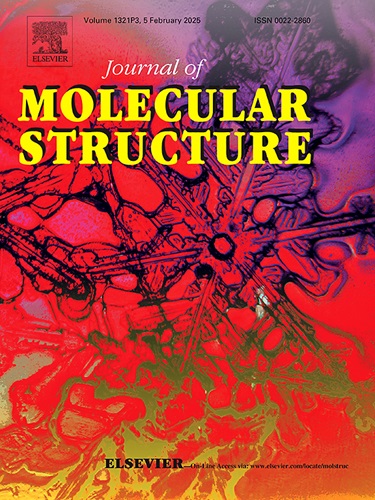固体酸催化双席夫碱的绿色合成:光谱、DFT、分子对接和 ADMET 研究
IF 4
2区 化学
Q2 CHEMISTRY, PHYSICAL
引用次数: 0
摘要
本研究以硫酸化二氧化钛为固体酸催化剂,通过无溶剂微波辅助对苯二胺与 3,4- 二甲氧基苯甲醛(I)和 3,4,5- 三甲氧基苯甲醛(II)缩合,研究了在 3,4- 二甲氧基和 3,4,5- 三甲氧基位置上具有苄基取代的双席夫碱的绿色合成。通过各种理化和光谱技术(包括红外光谱、¹H NMR、¹³C NMR 和 SC-XRD)确认了化合物的结构。化合物 II 在单斜系统中结晶(空间群为 P-21/c)。主要目的是利用实验方法和密度泛函理论(DFT)(B3LYP/6-311 G (d,p)水平)探索其几何结构。实验数据(傅立叶变换红外光谱、核磁共振、SC-XRD)与模拟数据的比较结果表明两者非常吻合。此外,还进行了 Hirshfeld 分析、ELF、LOL 和 RDG 拓扑研究。对 2V54 猴痘目标蛋白的对接模拟显示了化合物 I 和 II 的结合亲和力。目标蛋白与 I 和 II 的结合能分别为 4.83 和 -4.98 kcal/mol。ADMET 预测进一步证明了合成化合物的药理特性。本文章由计算机程序翻译,如有差异,请以英文原文为准。

Solid acid-catalyzed green synthesis of bis-Schiff bases: Spectroscopic, DFT, molecular docking, and ADMET studies
This research examines the green synthesis of bis-Schiff bases with benzyl substitutions at 3,4-dimethoxy and 3,4,5-trimethoxy positions through solvent-free microwave-assisted condensation between para-phenylenediamine and 3,4-dimethoxybenzaldehyde (I) and 3,4,5-trimethoxybenzaldehyde (II), using sulfated-TiO2 as a solid acid catalyst. The structures were confirmed through various physicochemical and spectroscopic techniques, including IR, ¹H NMR, ¹³C NMR, and SC-XRD. The compound II crystallized in the monoclinic system (space group of P-21/c). The primary objective was to explore the geometry using both experimental methods and density functional theory (DFT) with the B3LYP/6–311 G (d,p) level. A comparison of experimental (FT-IR, NMR, SC-XRD) and simulated data showed strong agreement. Additionally, Hirshfeld analysis, ELF, LOL, and RDG topological studies were performed. Docking simulations on the 2V54 monkeypox target protein revealed binding affinities, with compounds I and II. The target protein had a binding energy of 4.83 and −4.98 kcal/mol with I and II. ADMET predictions further demonstrated the pharmacological profile of the synthesized compounds.
求助全文
通过发布文献求助,成功后即可免费获取论文全文。
去求助
来源期刊

Journal of Molecular Structure
化学-物理化学
CiteScore
7.10
自引率
15.80%
发文量
2384
审稿时长
45 days
期刊介绍:
The Journal of Molecular Structure is dedicated to the publication of full-length articles and review papers, providing important new structural information on all types of chemical species including:
• Stable and unstable molecules in all types of environments (vapour, molecular beam, liquid, solution, liquid crystal, solid state, matrix-isolated, surface-absorbed etc.)
• Chemical intermediates
• Molecules in excited states
• Biological molecules
• Polymers.
The methods used may include any combination of spectroscopic and non-spectroscopic techniques, for example:
• Infrared spectroscopy (mid, far, near)
• Raman spectroscopy and non-linear Raman methods (CARS, etc.)
• Electronic absorption spectroscopy
• Optical rotatory dispersion and circular dichroism
• Fluorescence and phosphorescence techniques
• Electron spectroscopies (PES, XPS), EXAFS, etc.
• Microwave spectroscopy
• Electron diffraction
• NMR and ESR spectroscopies
• Mössbauer spectroscopy
• X-ray crystallography
• Charge Density Analyses
• Computational Studies (supplementing experimental methods)
We encourage publications combining theoretical and experimental approaches. The structural insights gained by the studies should be correlated with the properties, activity and/ or reactivity of the molecule under investigation and the relevance of this molecule and its implications should be discussed.
 求助内容:
求助内容: 应助结果提醒方式:
应助结果提醒方式:


